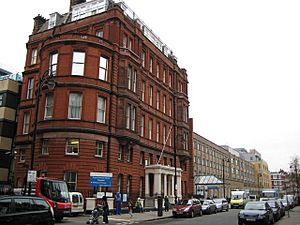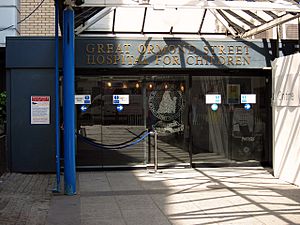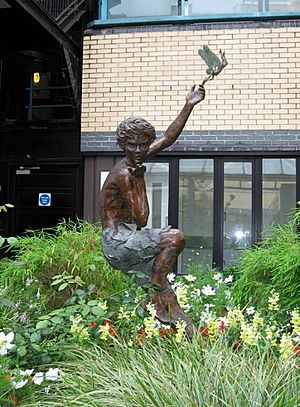Great Ormond Street Hospital facts for kids
Quick facts for kids Great Ormond Street Hospital |
|
|---|---|
| Great Ormond Street Hospital for Children NHS Foundation Trust | |

The view along Great Ormond Street
|
|
| Geography | |
| Location | Great Ormond Street, London, England |
| Coordinates | 51°31′21″N 0°07′14″W / 51.5225°N 0.1205°W |
| Organisation | |
| Care system | National Health Service |
| Hospital type | Teaching |
| Affiliated university | University College London |
| Services | |
| Emergency department | No |
| Beds | 389 |
| Speciality | Children's hospital |
| History | |
| Founded | 14 February 1852 |
Great Ormond Street Hospital (often called GOSH) is a famous hospital just for children. It is located in the Bloomsbury area of London, England. GOSH is part of the Great Ormond Street Hospital for Children NHS Foundation Trust.
This hospital is the biggest place in Britain for children's heart surgery. It is also one of the largest centers in the world for heart transplants. In 1962, GOSH created the first machine to help children with heart and lung problems. They also worked with children's author Roald Dahl to make a better valve for children with a condition called hydrocephalus (too much fluid in the brain). GOSH was also the first in the UK to test the rubella vaccine and perform the first bone marrow transplant for certain immune system problems.
GOSH is Europe's largest center for research and teaching about children's health. In 1929, the author J. M. Barrie gave the copyright for his famous story Peter Pan to the hospital. This means the hospital gets money from the story, which helps them care for children.
Contents
Hospital History
How GOSH Started
The Hospital for Sick Children, Great Ormond Street, opened on February 14, 1852. Dr. Charles West worked hard to make it happen. It was the first hospital in England to have beds specifically for children to stay overnight.
When it first opened, it only had 10 beds. But it grew into one of the world's top children's hospitals. Queen Victoria supported it, and famous writer Charles Dickens helped raise money. The Nurses League, a group for nurses, started in 1937.
Becoming Part of the NHS
In 1948, Great Ormond Street Hospital became part of the National Health Service (NHS). The NHS is a system that provides healthcare for everyone in the UK. For a while, it was harder for the hospital to raise money privately. However, they could still receive money left to them in wills.
Audrey Callaghan, whose husband James Callaghan was Prime Minister, was a leader at the hospital from 1968 to 1990. Diana, Princess of Wales, was also a patron (a supporter) of the hospital until her death in 1997.
Recent Developments
The Charles West School of Nursing moved to London South Bank University in 1995. In 2002, GOSH began a big plan to rebuild and update parts of the hospital. This project cost a lot of money and continued for many years.
In July 2012, Great Ormond Street Hospital was featured in the opening ceremony of the London Summer Olympics. This was a special moment that showed the hospital's importance. In 2017, the hospital received international attention because of a situation involving patient care decisions, known as the Charlie Gard treatment controversy.
Hospital Archives
The hospital keeps old records and documents, called archives. These records are available for people to research. You can even find admission records from 1852 to 1914 online.
St Christopher's Chapel
St Christopher's Chapel is a beautiful chapel inside the hospital. It is decorated in a special style called Byzantine. The chapel was designed by Edward Middleton Barry and built in 1875. It was built to remember Caroline Barry, Edward's sister-in-law. Her widower, William Henry Barry, paid for the chapel.
The chapel is a peaceful place for sick children and their families. Many of its details are about childhood. The stained glass windows show scenes from the childhood of Christ. The dome has a picture of a pelican feeding its young, which is a symbol of sacrifice.
When the old hospital buildings were taken down in the late 1980s, the chapel was carefully moved to its current spot. It was reopened in 1994 by Diana, Princess of Wales.
The Peter Pan Story
In April 1929, J. M. Barrie gave the copyright for his Peter Pan stories to Great Ormond Street Hospital. This means the hospital owns the rights to the story. They receive money from any plays, movies, or books made from Peter Pan. Barrie asked that the amount of money they received not be made public.
The hospital has allowed many plays and movies of Peter Pan to be made. They also asked an author, Geraldine McCaughrean, to write a sequel called Peter Pan in Scarlet, which was published in 2006.
In the UK, a special law was passed in 1988. This law gives the hospital a lasting right to collect money from public performances and commercial publications of Peter Pan in the UK. This helps the hospital continue its important work.
Great Ormond Street Hospital Children's Charity
The hospital has always needed help from charities. One of the main helpers is the Great Ormond Street Hospital Children's Charity. The NHS pays for the hospital's daily running costs. But the money raised by the charity helps GOSH stay at the top of child healthcare.
The charity aims to raise over £50 million each year. This money helps pay for new buildings, important research, and modern equipment. It also helps provide places for families and staff to stay.
The charity has received support from many places. For example, it benefited from the "Jeans for Genes" campaign, which helps children with genetic disorders. All the money from this campaign for GOSH went to its research partner, the UCL Institute of Child Health.
On August 6, 2009, Arsenal F.C. (a famous football club) chose the charity as their "charity of the season." They raised over £800,000 for a new lung function unit at the hospital.
Many famous people have helped raise money for GOSH.
- In 1987, a song called "The Wishing Well" was released by several artists, becoming a top 30 hit.
- In 2009, finalists from The X Factor sang "You Are Not Alone" by Michael Jackson. This song reached No.1 in the UK charts and helped the charity.
- Since 2010, Channel 4 has held a "Channel 4's Comedy Gala" event every year. This show brings together comedians to raise money for the charity.
- In 2011, Daniel Boys released a song called "The World Is Something You Can Imagine" to help the Disney Appeal at GOSH.
- In 2018, a group of celebrities called The Celebs recorded a Christmas song called "Rock With Rudolph". This song also helped Great Ormond Street Hospital. It was very popular, reaching number two on the iTunes pop chart.
Hospital Improvements
Great Ormond Street Hospital is always working to improve its services. This includes making sure the food is good and the hospital is clean. The hospital regularly checks these things and makes changes based on feedback.
Notable Staff
Many talented people have worked at Great Ormond Street Hospital. Some of them include:
- Lancelot Barrington-Ward, a surgeon
- Mildred Creak, a child psychiatrist
- Norman Bethune, a Canadian doctor
- Lewis Spitz, a surgeon
- Silvia Schievano, a professor of biomedical engineering
See also
 In Spanish: Great Ormond Street Hospital para niños
In Spanish: Great Ormond Street Hospital para niños
- Healthcare in London
- List of hospitals in England
- Evelina London Children's Hospital, London, UK
- Necker-Enfants Malades Hospital, Paris, France
- Hospital for Sick Children, Toronto, Ontario





